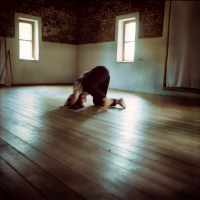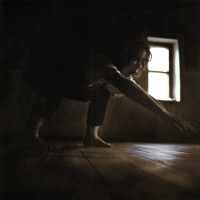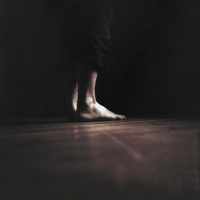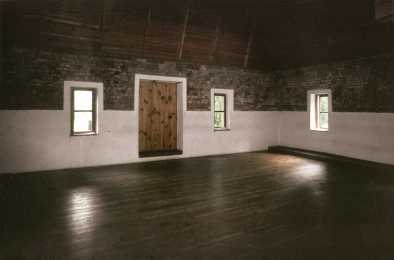11-042 jonkowo
węgajty 18
phone/fax: (0048-89) 5129297
art director: wacław sobaszek
 e-mail: wioskateatralna@gmail.com
how to get there
guest book
blog
links
e-mail: wioskateatralna@gmail.com
how to get there
guest book
blog
links
 e-mail: wioskateatralna@gmail.com
how to get there
guest book
blog
links
e-mail: wioskateatralna@gmail.com
how to get there
guest book
blog
links
workshops and expeditions
-
Questions concerning the craft of theatre:
* What parts does the whole called 'theatre' consist of?
* How word can become the beginning of theatre?
* What music can call into being new theatrical visions?
Questions concerning the connection between theatre creation and traditional culture:
* What meaning do the reconstruction and continuation of tradition have for theatre today?
* How do you reach folk culture?
* How to define anew the religious connotations of the artistic quest?
* Is village theatre needed and useful?
How to find the word, emerging out of the background? Word out of no-word, out of the void, out of silence, out of the background of ever indescribable, script-less, illiterate, naive culture, out of the background of common complaint, struggling conscience, religion-tinged psychosis, yearning to heal itself.
Look for the word where it has never been yet.
These questions - many a time causing controversy, calling forth emotions and resentments - can be practically tackled on one common ground, the one of a school. The school yields a possibility for focused, concentrated, solid work, for a fresh approach, with ever renewing young ensemble, considerable pool of energy, sensitivity, an attitude free of prejudice, naturally open and critical.
WINTER SCHOOL
The workshop is placed in the realm of the traditional performing practices and the rituals of the calendar cycle: from the beginning of the year till the end of the winter. The workshops are predominantly connected with mastering the forms and motifs of two phenomena: the Carpathian carolling plays as well as Easter carolling on the Polish-Lithuanian-Belarus border, and they serve to prepare the adepts for participation in expeditions to those regions.
We have been carolling for 12 years already. How far have we got? With increasing clarity we can see that carolling is an area of great diversity. At the moment, what is the most relevant and helpful is the truth realised by Jan Dorman. He explored carolling in the sixties and seventies and he came to regard it as a kind of commedia dell' arte: the characters and situations are fixed, yet a large portion of improvisation gives the performance unique flavour and energy.
The first and major task of a workshop participant is getting to know the language of theatre. By acquiring the basic theatre language skills, the adept will be able, in the finale of his apprenticeship cycle, which is in the expedition, reach other ingredients of the carolling substance: the ritual ones, the historical and site-based ones. This unique "melting pot of cultures", containing an immense variety of traditions, beliefs, rituals and languages, can only be known in the proper time and space, when the participant changes into an actor-caroller.
The theatre language of carolling consists of a definite (yet not finite) and constantly renewed set of motifs. A workshop participant has the chance to choose, depending on his predisposition, a couple of characters and masks. From the very start you are taught to suddenly assume your part and leave it, shape-shift, going through quick metamorphoses. We stress the importance of improvisation, changeability, being "in the stream", but by constant recurrence to ready motifs we try to inculcate in the adepts a careful and caring attitude to those motifs, which are supposed to be fixed and hieratically stable.
This way we introduce beginners into the carolling practice. Among them there are even people who have never in their life been in touch with theatre craft. Such people can also make their first steps in the musical field, as carolling is a great opportunity for music initiation. First of all, it is an initiation into vocal music, but also into playing an instrument. Quite often the first contact with the instrument made during carolling is so strong, that it helps later on to progress really fast when they start learning on their own. Sometimes the adepts come back as excellent self-taught musicians.
Another very important value of the apprentice-caroller's experience is getting to know the theatre audience - the hosts of all the houses. They co-create the show by their reactions, which often fulfil the convention of some unwritten script of the visit. It is only when they join in when the true meaning of the event is revealed. Then what is also present is the element of the fieldwork research: learning songs, memories kept in the living memory of the visited people. What also is of great importance during the expedition is the necessity to overcome technical obstacles, and for all the participants to be responsible for a whole range of practical and organisation tasks.
Wacław Sobaszek


-
The preparation to the expedition consists of 2-3 workshop sessions, usually taking 3 days each. During every session, similar forms of work are offered:
Traditional dance class. Work on the dances often performs the function of a warm-up at the beginning of the workshop session, yet its importance within the whole of the project is much broader: during our Christmas (or Easter) round of the houses, the dances often become the simplest language of communication between us and the hosts; they are also the source of theatre improvisation transcending the scenario of the show.
Actor's workshop. Its form can vary depending on the needs of a given apprentice group, their previous preparation etc. The starting point is various movement tasks. The work leads to creating space for the words upon which the performance is based. It is not, however, an acting workshop in the strict sense of the word.
Voice workshop. Its purpose is overcoming or rather going round all kinds of voice blocks or 'thresholds'. In our sessions, work on voice is often an integral part of theatre workshop. However, in the workshops of our Summer School in 1999 we introduced the practice ofindependent sessions based on breathing exercises and music improvisation.
Learning songs: Polish and Ukrainian carols, Easter songs, the so-called "volochebne" or "veshnanki" ('villagers') from Ukraine and Belarus. The starting point in creating the repertoire was the collection of songs "gathered" during fieldwork expeditions, we also use ethnographical sources, Kolberg's collections etc. It is important that we not only teach the adepts particular songs (there should be as many as possible), but also certain truthfulness and discipline in the performance thereof - so that they can become a clear, expressive language.
Rehearsals of the "house play". Basic theatrical material consists of motifs taken from Carpathian carolling practice; the goat scene, the beheading of Herodus, the Jew scene - we assume that they are in the main broadly known. To that we add the Warmian stork mask and other, newer and newer, characters. For the Easter carolling, so-called "little orations" ("oracyjka") are prepared. They are often quite elaborate rhetoric forms, comprising, among other things, Easter wishes and requests for gifts.
Each rehearsal of the house play starts with the initial phase: learning a couple of traditional dances: various kinds of polka, oberek, as well as some Lithuanian and Jewish dances. The next step is work on "under-the-window" carolling. During the expedition it performs the special role of announcing the carollers' arrival; it is often performed to the accompaniment of some instrument, for example the shepherd's horn. During the rehearsal, the song is performed many times, often in a marched passage or procession.
To work on the "Goat scene" or "Herodus scene", a small space is separated in the theatre room, imitating, by its size, the tight interior of a village hut. The work pattern is very simple: by way of instruction, a non-comment demonstration of a given scene by one of the leading person will do. All is about reacting quickly to a quoted passage of the text or musical motif preceding the scene. This aural cue is supposed to spur the adept to momentarily decide he or she will "take" a given part. The adept runs out of the circle of"spectators" behind the door, to come back after a moment disguised as the Goat, the Gypsy, Herodus etc, and perform the appropriate song motif, a passage from the play's text, a gesture, a dance. This situation is repeated many times, so that each of the participants may be able to undertake the task several times. There is some touch of living room entertainment in it: every bit of performance which is outstanding by its jest, wittiness or expressiveness brings forth in the others willingness to try the bit themselves and to do no worse than the predecessor has... What is very essential is a good amount of caution and some self-restraint on part of the instructors. By abstaining from unnecessary comment, they should encourage the adepts' own activity, so that each of them builds up their"own" Goat, their "own" Herodus, gradually gaining command of the costume, the mask, the props end their own, special use of them. The most essential costumes and props come from village carolling groups: the Szemel and the Goat were used by Węgajty village carollers until mid-seventies; the Gypsy's costume belonged to Żywiec "Dziady" ("Ancestors") group's equipment. The director's remarks are mostly limited to correcting errors in the execution of a given part: e.g., the monument-of-culture that the Goats head is must not be smashed when the Goat falls down; Herodus' mask should be properly lit with the wooden "fanarek" lamp etc. What takes a lot of effort is perfecting the right rhythm of the scenes' sequence; a serious obstacle seems to be an occasional case of "actor's approach" or "psychological approach" or of simple tardiness.
In the course of the evening and consecutive rehearsals, we repeat longer and longer passages from the show. What we hope to arrive at, however, is the transgression of its scenario: dances and theatre improvisations of all the masks announce the passage into the next phase of the winter masking - into the carnival.
Workshop participation does not require any extraordinary skills. What is very important, though, is keeping the right proportion between the participation of entirely inexperienced persons and the co-operation of the older "years" of the carolling. We try to choose such participants as have consciously decided to take part both in the workshops and the expedition. It is because only real carolling decides whether a given adept has really fulfilled the cycle. Carolling is not a purely cognitive experience - in relation to the visited people it can often be called some kind of "deed", a kind of service. That's why we demand a sense of responsibility and the readiness to undertake large physical strain. One should bear in mind, that the arrival and activity of "strangers" within the village community always has some taste of provocation. It is therefore a mere security measure to keep constant mutual contact within the group. The quickest means of communication in case of some mistake or a spell of drowsiness and sudden loss of alertness proves to be a common nudge.
During the carolling - whether during Easter or Christmas period - we strive to visit all the houses in the village, disregarding any internal divisions within the village. It is extremely difficult, sometimes even impossible. Many times behind those doors which were apparently closed to us, the most precious meetings came about. The finale of the whole round is a dancing party for everyone, including the less advanced adepts coming from the city just for the dance. Another way of making the experience last longer is participating in a session of the Theatre Seminar in Węgajty. In recent years those sessions have been occasions for undertaking yet further workshop tasks, for transforming the carolling house play into the carnival performance Ostatki, zapusty - syncretic performance. It is an open dramatic form, each year re-constructed with another apprentice group. Workshops and demonstrations are accompanied by complementary forms: lectures, film projections, exhibitions, discussions.
Erdmute Sobaszek


up
design: © Grzegorz Kumorowicz 




